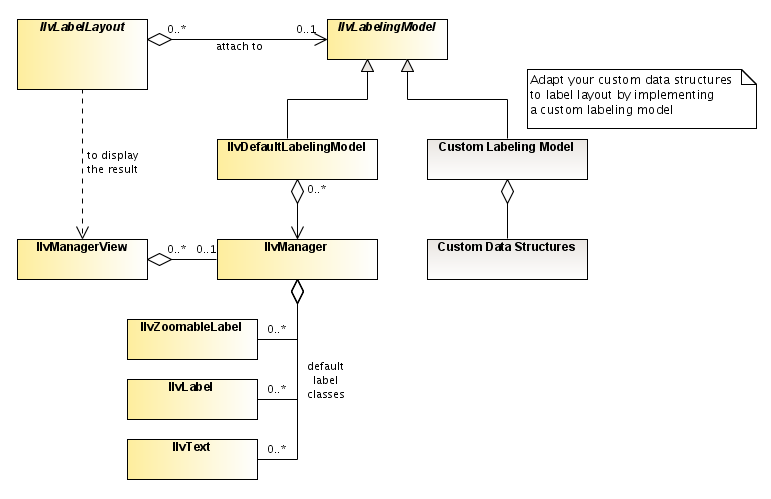The methods defined in the IlvLabelingModel class can be divided into
several categories: those that provide information on the structure
of the labels and obstacles, on their geometry, on their overlap
penalty, and notification of changes in the manager.
They are described in the following
sections:

Class diagram for IlvLabelingModel
Information on the structure of labels and obstacles
The following methods of the
IlvLabelingModel
class allow the layout algorithms to retrieve information on the
labels:
Decides
whether an object is a label. |
|
Enumerates
all existing labels. |
|
Returns
the number of labels that exist. |
The following methods allow the layout
algorithms to retrieve information on the obstacles in a similar
way:
boolean isObstacle(Object obj)
boolean isPolylineObstacle(Object obj)
Enumeration getObstacles()
int getObstaclesCount()
For optimization purposes, the labeling
model distinguishes between normal obstacles and polyline
obstacles. While normal obstacles cover the major part of their
bounding box, polyline obstacles have a line width and range over
intermediate points; thus they cover only a small part of their
bounding box.
Since a polyline obstacle is an obstacle, both
isObstacle
and
isPolylineObstacle
return
true
for a polyline obstacle.
Information on the geometry of labels and obstacles
For labels and obstacles, the label layout
can retrieve the bounding box with the method:
IlvRect boundingBox(Object labelOrObstacle)
For the special polyline obstacles, the
label layout can retrieve the precise shape of the polyline with
the methods:
float getPolylineWidth(Object polylineObstacle)
IlvPoint[] getPolylinePoints(Object polylineObstacle)
The following method moves a label to the
new position.
void moveLabel(Object label, float x, float y, boolean redraw)
Overlap calculation
A good label layout avoids overlaps. Thus,
the calculation of overlap values is an important step of the
algorithm. The speed of the layout algorithm depends crucially on
the speed of the overlap calculation. The labeling model provides
the following methods for overlap calculations:
Calculates
the overlap between two labels. |
|
Calculates
the overlap between a label and a normal obstacle. |
|
Calculates
the overlap between a label and a polyline obstacle. |
These methods return a positive penalty
value that indicates how much the objects overlap.
- The returned value is 0 if the objects do not overlap.
- A smaller overlap value designates less overlap than a larger overlap value. The actual number is arbitrary and depends on the implementer of the labeling model. For example, if all objects are rectangles, then it could be the size of the overlapping area of the rectangles.
Typically the overlap value is calculated
before the label is moved. It is calculated for a speculative
label position, not for the real label position. Hence, the
speculative bounding box of the label is passed as an argument.
Similarly, the bounding box (or polyline shape) of the obstacle
is passed as an argument as well. The meaning of the returned
value is the overlap penalty if the label were placed at its
passed bounding box, and the obstacle were placed at its passed
bounding box.
If the overlap methods return a positive nonzero penalty only
when the speculative bounding boxes overlap, then the following
method can return
true
:
boolean isBoundingBoxDependent()
This method exists mainly for quadtree
optimization purposes.
Notification of changes
The following methods of the
IlvLabelingModel
class allow a layout algorithm to be notified of changes in the
data structures:
void addLabelingModelListener(LabelingModelListener listener)
void removeLabelingModelListener(LabelingModelListener listener)
void fireLabelingModelEvent(Object obstacleOrLabel, int eventType, boolean adjusting)
void fireLabelingModelEvent(LabelingModelEvent event)
A “change” can be a structural change (that is, a label or
obstacle was added or removed) or a geometrical change (that is,
a label or obstacle was moved or reshaped). The event type is
typically a bitwise-Or of the bit masks defined in the class
LabelingModelEvent
. For instance, when a label was removed, an event with type
(STRUCTURE_CHANGED | LABEL_REMOVED)
is fired and the removed label is stored in the event. The
labeling model event listener mechanism provides a means to keep
the layout algorithms informed of these changes. When the layout
algorithm is restarted on the same graph, it is able to detect
whether the data structures have changed since the last time the
layout was successfully performed. If necessary the layout can be
performed again. If there was no change, the layout algorithm can
avoid unnecessary work by not performing the layout.
The labeling model event listener is defined by the LabelingModelListener interface. To receive
the events (that is, instances of the LabelingModelEvent class), a class must
implement the
LabelingModelListener
interface and must register itself using the addLabelingModelListener method of the
IlvLabelingModel
class.
Note
The label layout algorithms register themselves as listeners to
the labeling model (via the functionality in
IlvLabelLayout
). Therefore, there is usually no need to manipulate these
listeners directly.
Storing and retrieving object properties
The following methods of the
IlvLabelingModel
class allow a layout algorithm to store data objects for each
label or obstacle:
void setProperty(Object labelOrObstacle, String key, Object value)
Object getProperty(Object labelOrObstacle, String key)
void setProperty(String key, Object value)
Object getProperty(String key)
The layout algorithm may need to associate a set of properties
with the labels or obstacles, or global properties. Properties
are a set of
key-value
pairs, where the
key
is a
String
object and the
value
can be any kind of information value.